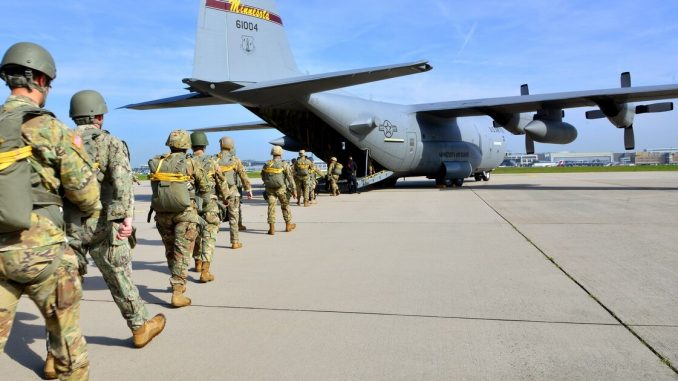
BERLIN (AP) — Defense Secretary Lloyd Austin told Germany’s Defense Minister Annegret Kramp-Karrenbauer in his first conversation with her since taking up his new post that Germany is “highly valued” as a station for American soldiers, the Defense Ministry said Thursday.
Last year, then President Donald Trump ordered the reduction of the U.S. military contingent stationed in Germany by more than 25 percent and the Pentagon has been studying how that could be done.
German officials have hoped that order will be rescinded by the new administration, and the German Defense Ministry said that in his call with Kramp-Karrenbauer on Wednesday, Austin “emphasized that Germany is highly valued as a station and that American soldiers feel very comfortable here.”
“The U.S. continues to consider its presence in Germany as an important part of joint security,” the Defense Ministry said in a readout of the call.
About 34,500 U.S. troops are stationed in Germany, which includes key American military facilities like the Ramstein Air Base and the headquarters for U.S. European Command and U.S. Africa Command.
DoD spokesman John Kirby said Austin “expressed his gratitude to Germany for continuing to serve as a great host for U.S. forces, and expressed his desire for a continued dialogue on U.S. force posture in Germany.”
The two officials also discussed a range of other issues including NATO cooperation, and the security situations in Afghanistan and Iraq.
Kirby said Austin wanted to “reinforce the value the United States places on the bilateral defense relationship with one of our closest NATO Allies.”
After Trump announced his order to reduce troos in Germany in late July, then-Defense Secretary Mark Esper said some of those units could begin moving within “a matter of weeks.” But so far, the 2nd Cavalry Regiment, AFRICOM and EUCOM headquarters and others are still in Germany.
/cloudfront-us-east-1.images.arcpublishing.com/mco/X2NVWAIVWZFWVAYLYPYPTU3SZA.jpg)
Lawmakers at the time questioned the wisdom of such a move and suggested it would be unlikely to survive should Trump lose the election.
“I do believe that if there’s a change in the administration, that this will not happen,” Rep. Ruben Gallego, D-Ariz., told Military Times on Oct. 15 during a press call.
Weeks later, Gallego and his colleagues passed their version of the 2021 National Defense Authorization Act, which includes a provision that no troops be removed from Germany until the Defense Department submits a detailed timeline and financial plan for the withdrawal, then carries out a waiting period of 120 days.
/cloudfront-us-east-1.images.arcpublishing.com/mco/TZDVNNX6KBAVLOOSN7ARVZONE4.jpg)
Though the Pentagon had proposed moving 12,000 troops out of Germany, officials could not offer details about the cost or the proposed timeline for carrying out the plan.
“I’m really having a problem connecting the dots with whether this is going to solve a problem, that I don’t think exists,” Jim Langevin, D-R.I., said during a House Armed Services Committee hearing in September. “In fact, I think it’s going to create more problems than anything it’s going to solve.”
Both sides of the aisle were skeptical, as Pentagon officials declined to offer any details other than a cost estimate in the single-digit billions, repeating Esper’s July remarks that rotational deployments farther East made more sense for Russia deterrence.
“… there needs to be an overall strategic plan that is coordinated with allies, rather than have a bunch of rationalizations after the fact,” then-HASC ranking member Rep. Mac Thornberry, R-Texas, said at the time.



Be the first to comment